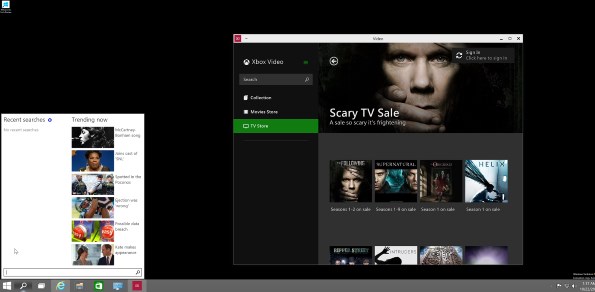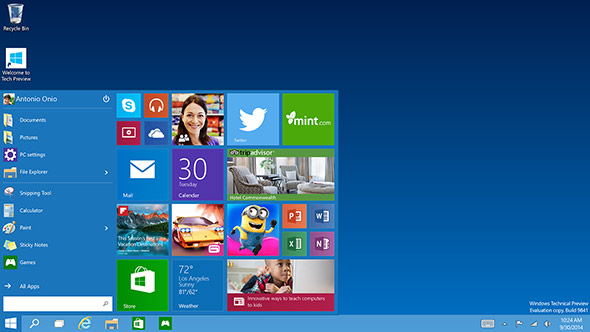Windows 10 Hands-On: What You Need To Know
Introduction: From Windows 8 to Windows 10
It has been a few weeks since Microsoft released its Technical Preview of Windows 10 -- which means we've had enough time to walk around the vehicle, kick the tires, and investigate the product in its current form. After the drubbing that Windows 8 took in the tech press and from angry users, Microsoft badly needs this new operating system to be a success, but simply cramming the Start menu back into the OS isn't going to cut it. So what has Microsoft been up to all this time beyond the Start menu's triumphant return? Let's take a look.
The Road To Windows 10
We want to kick off this preview by briefly discussing something that's been percolating in the back of our heads for quite some time. Specifically: We think Microsoft (or at least important people within Microsoft) were caught off-guard by the sustained dislike many consumers had for Windows 8. Long after the familiarity bias should've faded, a number of reviewers and tech aficionados remained opposed to the OS -- and we think that's actually partly the fault of the technical press because certain issues weren't communicated more effectively.
I can only speak for myself, but when we wrote our Windows 8 preview coverage, I was impressed and excited by the bold new direction Microsoft was charting. After years of refining the old Desktop paradigm, this was MS trying something altogether different. The reason I was so pleased with this in 2011 and so unhappy with the final product was simple -- I assumed Microsoft was going to fix all the little problems and issues that collectively sank Windows 8 and continue to diminish Windows 8.1. I assumed, for example, that Desktop and Metro apps would be able to communicate effectively, that Windows RT versions of apps would be well tuned to run on RT devices, that basic Metro apps like the Photo Viewer would ship with the same capabilities as the Windows Photo Viewer, but with a specialized touch interface, that file lists would have customizable layouts, that file names could be displayed by default in those layouts, that users would be able to save sets of pinned applications rather than disrupting them with a simple alt-tab. I thought the decision to display information in low-density screen formats would be optional, not hard-coded into the system.
The bottom line is, a great many retrospective warning signs were treated instead as passing issues that Microsoft would undoubtedly resolve. The cost of not resolving many of these factors was Windows 8's mediocre uptake; two years after launch, the OS has just 30.31% of the Steam user market, compared to Windows 7's cumulative 62.32%. Windows 8's total share of the OS market is much smaller, but Steam's hardware survey is much more likely to represent our readership.
Don't mistake us here -- it's still important to evaluate Windows 10 as a work-in-progress -- but we're going to be more critical of the little things this time around. The good news is, there are significantly fewer issues to talk about.
The Road To Windows 10
We want to kick off this preview by briefly discussing something that's been percolating in the back of our heads for quite some time. Specifically: We think Microsoft (or at least important people within Microsoft) were caught off-guard by the sustained dislike many consumers had for Windows 8. Long after the familiarity bias should've faded, a number of reviewers and tech aficionados remained opposed to the OS -- and we think that's actually partly the fault of the technical press because certain issues weren't communicated more effectively.
I can only speak for myself, but when we wrote our Windows 8 preview coverage, I was impressed and excited by the bold new direction Microsoft was charting. After years of refining the old Desktop paradigm, this was MS trying something altogether different. The reason I was so pleased with this in 2011 and so unhappy with the final product was simple -- I assumed Microsoft was going to fix all the little problems and issues that collectively sank Windows 8 and continue to diminish Windows 8.1. I assumed, for example, that Desktop and Metro apps would be able to communicate effectively, that Windows RT versions of apps would be well tuned to run on RT devices, that basic Metro apps like the Photo Viewer would ship with the same capabilities as the Windows Photo Viewer, but with a specialized touch interface, that file lists would have customizable layouts, that file names could be displayed by default in those layouts, that users would be able to save sets of pinned applications rather than disrupting them with a simple alt-tab. I thought the decision to display information in low-density screen formats would be optional, not hard-coded into the system.
The bottom line is, a great many retrospective warning signs were treated instead as passing issues that Microsoft would undoubtedly resolve. The cost of not resolving many of these factors was Windows 8's mediocre uptake; two years after launch, the OS has just 30.31% of the Steam user market, compared to Windows 7's cumulative 62.32%. Windows 8's total share of the OS market is much smaller, but Steam's hardware survey is much more likely to represent our readership.
Don't mistake us here -- it's still important to evaluate Windows 10 as a work-in-progress -- but we're going to be more critical of the little things this time around. The good news is, there are significantly fewer issues to talk about.








